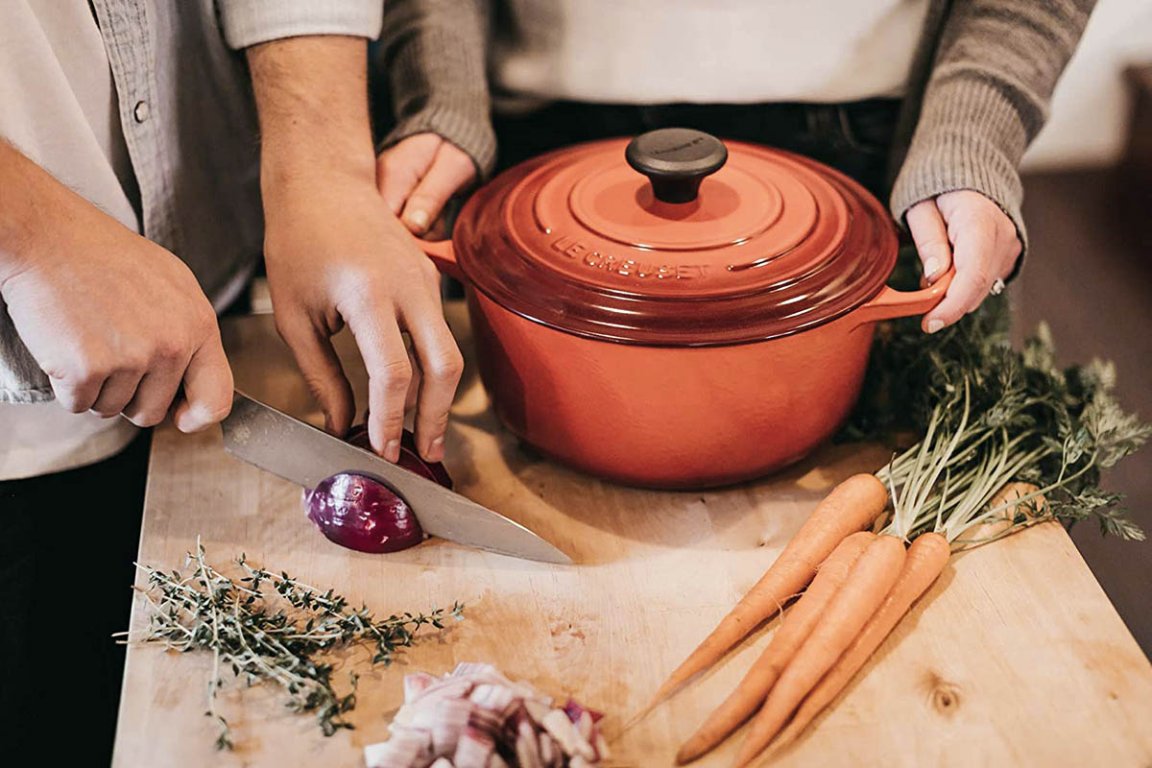We may earn revenue from the products available on this page and participate in affiliate programs. Learn More ›
Both experienced home chefs and culinary beginners are always on the lookout for cookware that helps them produce mouthwatering results. The best cookware brands offer a wide variety of vessels in myriad shapes and sizes that are made with substantial materials such as cast iron, hard-anodized aluminum, stainless steel, and ceramic. Additionally, many cookware products feature nonstick coatings to reduce the time and effort involved in cleanup chores.
Supplementary features add value to today’s cookware. Ergonomically designed handles made from cushiony materials provide secure and safe handling. Contemporary cookware brands offer a plethora of attractively designed cookware in scrumptious colors to enliven the cooking experience. Ahead, discover the best cookware brands to meet and even exceed your culinary needs.
1. All-Clad
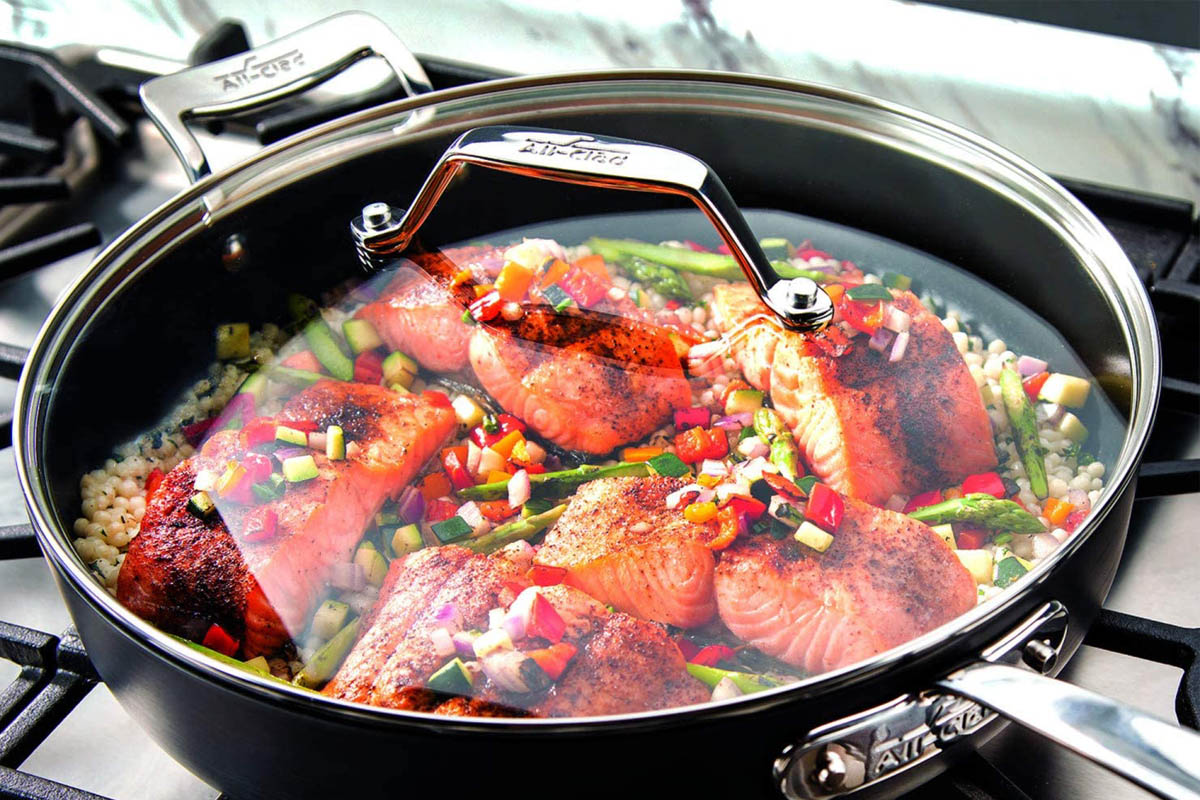
About the Brand: The durable quality and culinary performance of All-Clad cookware come from its multiple bonded layers of stainless steel and aluminum construction, with options for nonstick coatings and copper cores.
Price Range: $ to $$$$
Today, All-Clad has become one of the leading brands for cookware, bakeware, appliances, kitchen tools, and accessories. Materials include non-coated stainless steel in polished and brushed finishes, as well as hard-anodized aluminum and pieces with nonstick coating applied over the metal.
All-Clad’s copper-core cookware features layers of copper bonded with stainless steel to improve heat dispersion and control, resulting in even cooking. The graphite core pieces contain layers of graphite to amplify heat conductivity. Cooks enjoy the graphite’s weight, which is 80 percent lighter than copper. The FUSIONTEC pieces have steel cores with attractive ceramic exteriors for function and beauty from oven to table.
Top Products:
- All-Clad Essentials Nonstick Cookware Set: The versatile 10-piece set is constructed from heavy-gauge, hard-anodized aluminum that’s coated with three layers of nonstick material for easy cleanup. Get the All-Clad Essentials Nonstick Cookware Set on Amazon for $399.95
- All-Clad Copper Core 5-Ply Bonded Cookware Set: This 14-piece set of dishwasher-safe cookware has a copper core for fast and even cooking. The cookware is compatible with induction, oven, and broilers up to 600 degrees Fahrenheit. Get the All-Clad Copper Core 5-Ply Cookware Set on Amazon for $2,199.95
Shop for more All-Clad cookware at:
2. Calphalon
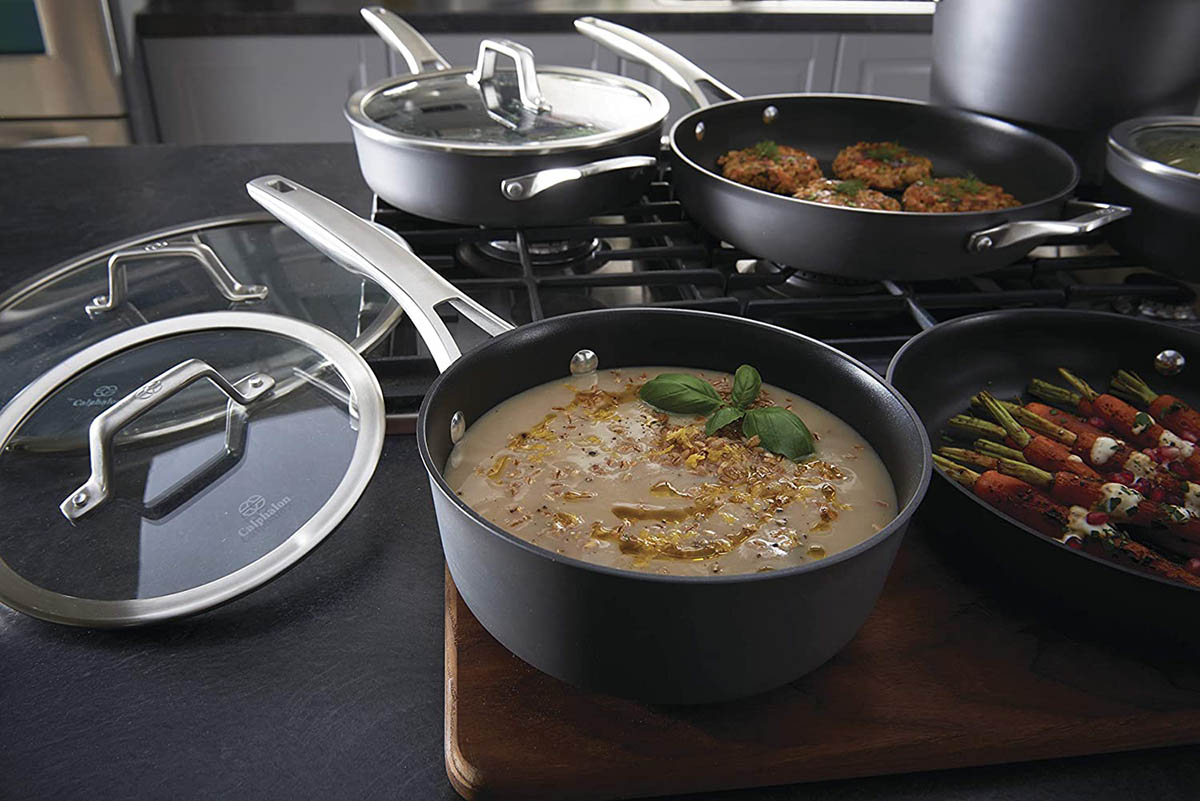
About the Brand: The Calphalon company pioneered the production of hard-anodized aluminum cookware. This cookware brand’s product line has grown to encompass a broad selection of cookware and bakeware made from a variety of materials.
Price Range: $ to $$$
Since Calphalon originated in professional kitchens, the company has always been dedicated to consumer education. With a history of supplying cooking schools and offering in-store cooking demonstrations, Calphalon continues today to offer its culinary expertise to its customers.
Although the Calphalon company built its reputation on high-quality hard-anodized aluminum cookware, they also offer a wide array of cookware, bakeware, cutlery, and utensils made from cast iron, ceramic, stainless steel, and nonstick materials. Additionally, Calphalon carries an extensive line of kitchen appliances, such as coffee makers, blenders, and countertop convection ovens.
Top Products:
- Calphalon Premier Hard-Anodized Nonstick 11-Piece Cookware Set: The saucepans, fry pans, and stockpot in this set feature three layers of hard-anodized aluminum coated with nonstick material to ensure durability as well as easier cleanup. Get the Calphalon Premier Hard-Anodized Nonstick 11-Piece Cookware Set on Amazon for $319.99
- Calphalon Classic Stainless Steel Multi-Pot Cookware: With their aluminum bases, the 8-quart stockpot, pasta insert, and steamer insert can be used on the stove, in the oven, and cleaned in the dishwasher. Get the Calphalon Classic Stainless Steel Multi-Pot Cookware on Amazon for $84.99
Shop for more Calphalon cookware at:
3. Cuisinart
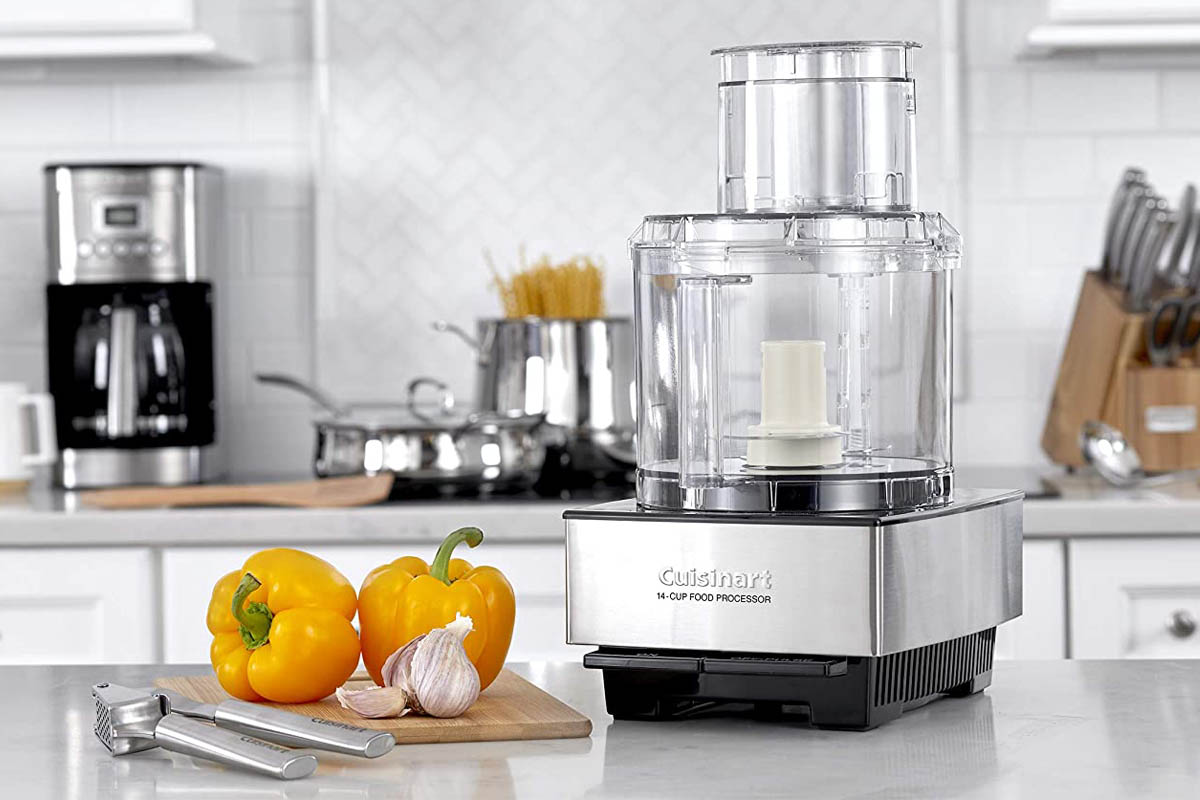
About the Brand: Since 1973, Cuisinart food processors have made prep work easier for home chefs, since expanding to offer a large selection of cookware, bakeware, kitchen gadgets, outdoor-grilling tools, and more.
Price Range: $ to $$$
Today, Cuisinart offers a vast array of high-quality cooking and baking products for home chefs. The Cuisinart line of cookware includes saucepans, griddles, chafing dishes, sauté pans, roasting pans, skillets, stockpots, and more.
Cookware materials include stainless steel, uncoated cast iron, enamel-coated cast iron, and hard-anodized aluminum. Offering a large selection of cookware pieces in multiple shapes and sizes, Cuisinart cookware meets the needs of home chefs for a plethora of everyday and specialty cooking projects.
Top Products:
- Cuisinart Chef’s Classic Stainless Cookware Set: An 11-piece stainless steel cookware set, this has the look of copper and is oven safe up to 500 degrees Fahrenheit. Get the Cuisanart Chef’s Classic Stainless Cookware Set on Amazon for $229.99
- Cuisinart 12 Piece GreenGourmet Set: This 12-piece cookware set is nonstick, stackable, PTFE and PFOA free, and oven safe. The stay-cool handles are made with 70 percent recycled stainless steel. Get the Cuisinart 12 Piece GreenGourmet Set at Wayfair for $259.95
Shop for more Cuisinart cookware at:
4. Le Creuset
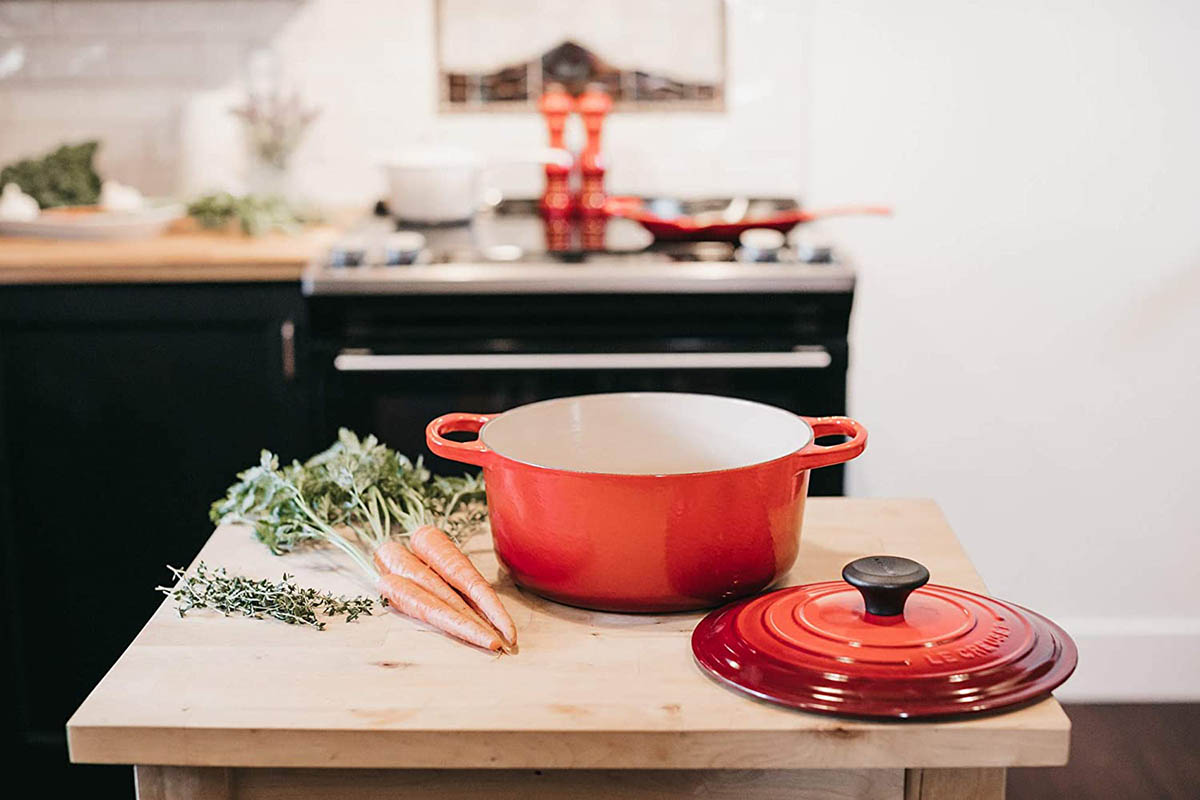
About the Brand: A pioneer in stylish and colorful cookware, the French company Le Creuset is known for durable, high-quality cast-iron cookware.
Price Range: $$ to $$$$
Since 1976, Le Creuset has committed to creating beautiful yet functional beloved Dutch ovens, high-quality cookware, and more.
The brand uses chip-resistant, enameled cast-iron materials in its products to produce durable, heirloom-quality pieces that last for years. The array of vibrant colors and signature gradient finishes make Le Creuset cookware distinctive and desirable for stylish kitchens around the globe. Although they are priced at the upper end of the spectrum, long-lasting Le Creuset pieces may serve multiple generations of cooks.
Today, the Le Creuset product line produces vivid, durable enameled cookware in a broad array of materials, including stoneware, silicone, enamel-coated steel, and cast iron. In addition to enamel, the company offers cookware with alternative finishes such as their “Toughened Nonstick PRO” signature stainless steel and nonstick metal bakeware.
Top Products:
- Le Creuset Enameled Cast Iron Dutch Oven: This 7.25-quart round Dutch oven features a wear-resistant finish along with superior heat distribution and extra-large handles for a secure grip. Get the Le Creuset Enameled Cast Iron Dutch Oven on Amazon for $389.95
- Le Creuset Multi-Purpose Enameled Cast Iron Cookware Set: The multipurpose nonstick 8-piece set is offered in several colors, and it is dishwasher safe. Get the Le Creuset Multi-Purpose Enameled Cast Iron Cookware Set on Amazon for $729.95
- Le Creuset Enamel On Steel Stockpot: Available in six colors, the 10-quart stockpot has a stainless steel rim, heavy-gauge carbon steel construction, and a porcelain enamel finish. Get the Le Creuset Enamel On Steel Stockpot on Amazon for $114.95
Shop for more Le Creuset cookware at:
5. STAUB
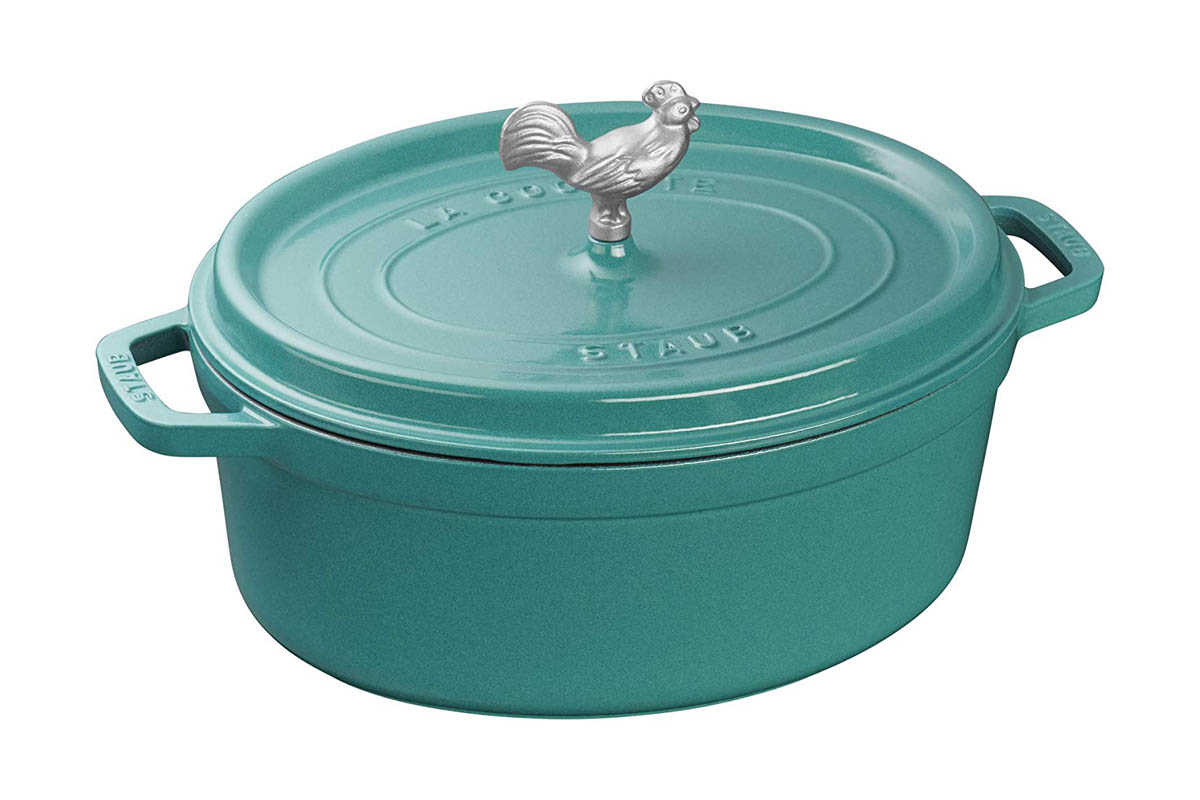
About the Brand: The enamel-coated cast-iron cocottes (Dutch ovens) manufactured by STAUB feature nubs on the undersides of their lids to allow condensation to collect and drip uniformly to baste the simmering contents in delicious juices.
Price Range: $$ to $$$$
Home cooks and professional chefs alike utilize STAUB‘s quality cookware. The enamel finishes make the brand’s cookware resistant to wear and easy to clean. Although the products are somewhat expensive, many cooks realize the long-lasting benefits of STAUB cookware. There’s products for cooking and baking, and different sized pieces available in cocottes, braisers, oval and rectangular baking dishes, and more.
In addition to enamel-coated cast-iron cookware, Staub offers a variety of ceramic pieces in lovely hues with diverse shapes and sizes, including prep bowls, serving bowls, trays, pitchers, and mugs. STAUB’s colorful ceramic tableware pieces include salt and pepper sets, egg cups, butter dishes, and utensil holders.
Top Products:
- Staub Cast Iron 5.75-quart Coq au Vin Cocotte: The cast-iron pot has a heavy weight, strong durability, and a choice of vibrant enamel finishes. Get the Staub Cast Iron Coq au Vin Cocotte at Amazon for $369.95
- Staub Cast Iron 3.5-quart Braiser with Glass Lid: With a domed glass lid, this cast- iron pan has an enamel finish and a textured black matte enamel interior. Get the Staub Cast Iron 3.5-quart Braiser with Glass Lid at Target for $169.95
Shop for more STAUB cookware at:
6. Lodge
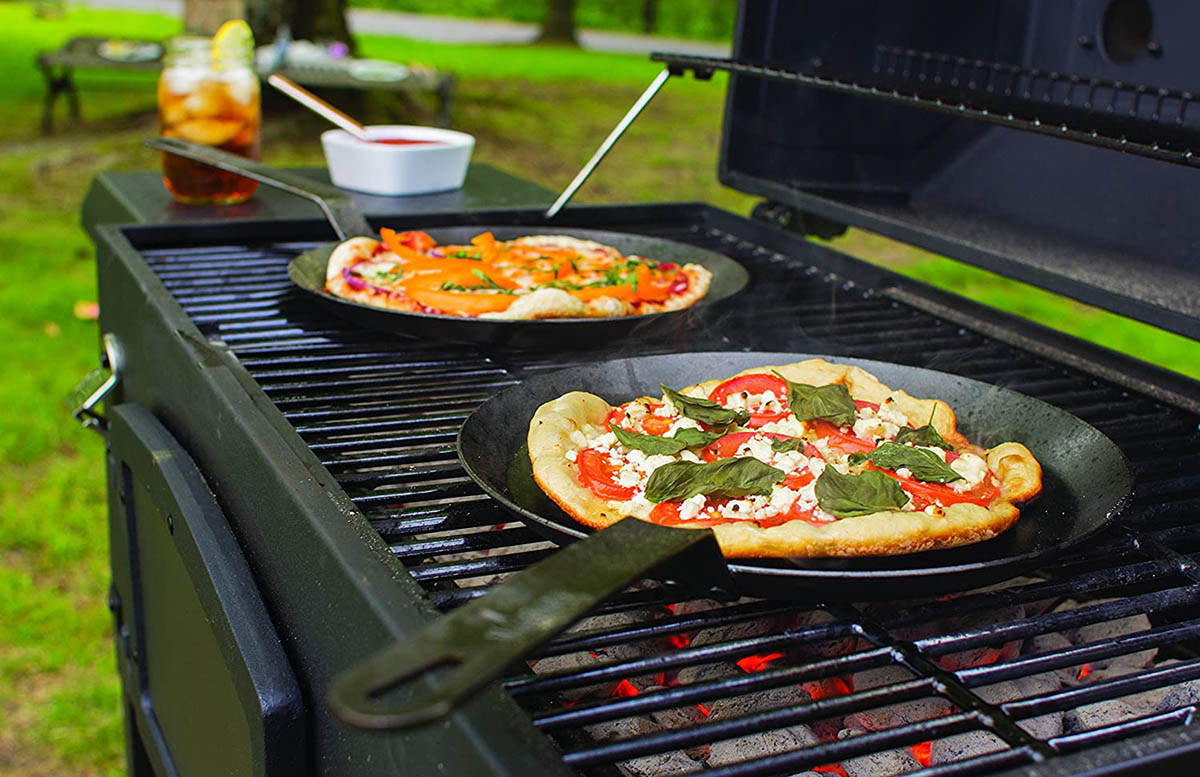
About the Brand: Lodge specializes in unbreakable, long-lasting cast-iron and carbon-steel cookware that’s easy to maintain and may make food taste better.
Price Range: $ to $$
Founded in Pittsburg, Tennessee, in 1896, Lodge Cast Iron offers an assortment of cookware pieces in uncoated cast iron. When properly seasoned and used according to Lodge’s instructions, the cookware is nonstick, easy to clean, and will last a lifetime.
Ideal for roasting, baking, searing, and frying, Lodge cookware can be used on stovetops, outdoor grills, or open campfires. Moreover, Lodge offers an assortment of specialized pieces for outdoor grilling, as well as a wide selection of accessories, including cookbooks, utensils, dish towels, silicone handle mitts, camp-cooking equipment, and more.
Top Products:
- Lodge Carbon Steel Skillet: A pre-seasoned 8-inch 12-gauge carbon-steel skillet only gets better with continued use and seasoning. Get the Lodge Carbon Steel Skillet on Amazon for $34.90
- Lodge 5 Piece Cast Iron Cookware Set: Oven safe and induction compatible, this set includes two frying pans, a griddle, and a Dutch oven. Get the Lodge 5 Piece Cast Iron Cookware Set at Wayfair for $89.90
- Lodge Cast Iron Enamel Dutch Oven: This red 6-quart Dutch oven can be used with induction cooktops and comes with pot protectors. Get the Lodge Cast Iron Enamel Dutch Oven at Target for $79.99
Shop for more Lodge cookware at:
7. T-fal
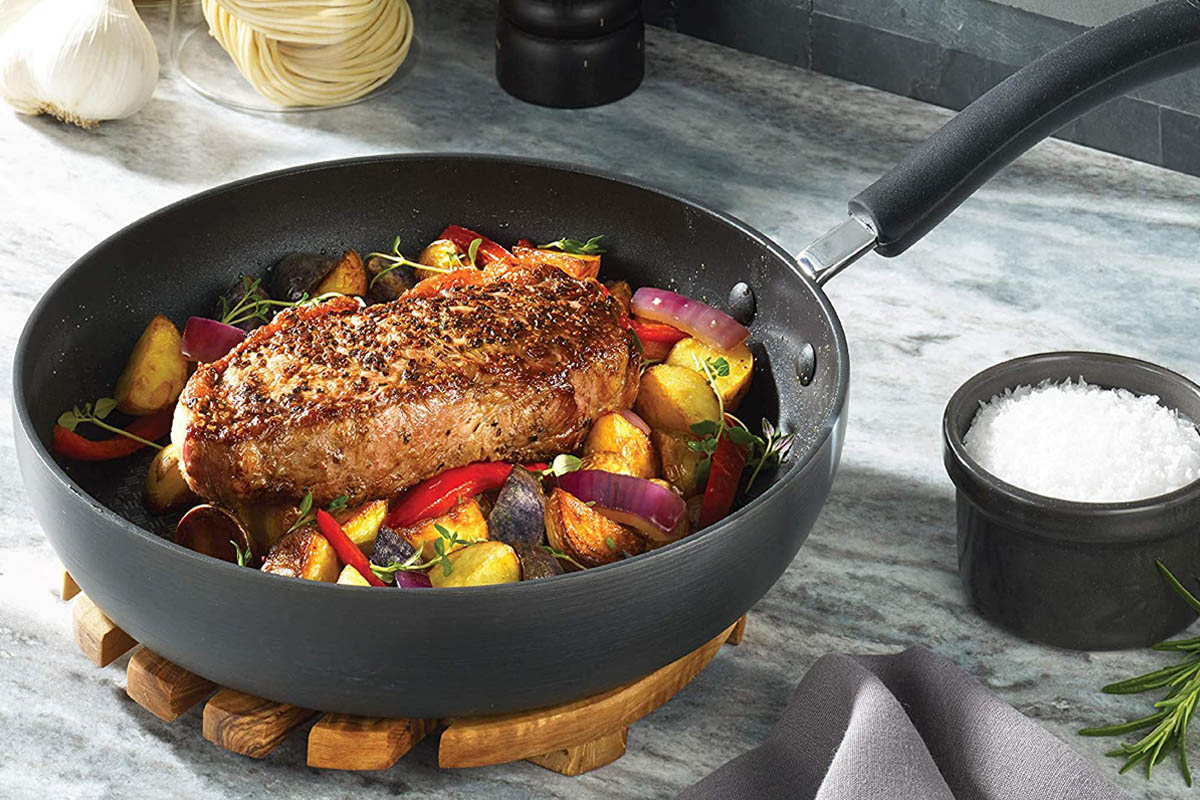
About the Brand: The T-fal company was the first to introduce Teflon-coated nonstick cookware to the public, liberating home cooks from the chore of scrubbing stuck-on food from pots and pans.
Price Range: $ to $$
T-fal offers nonstick cookware in sets or as individual pieces, including fry pans, saucepans, Dutch ovens, and more. The fry pans are constructed with T-fal’s patented Thermo-Spot technology, which features a central red dot to alert the cook that the pan is ready for cooking.
Available in a variety of attractive colors, T-fal cookware is dishwasher safe and designed ergonomically for easy handling. The nonstick interiors are scratch resistant for long-lasting durability.
Top Products:
- T-fal Nonstick Dishwasher Safe Fry Pan: The 10-inch pan is made of hard-anodized aluminum that’s reinforced with titanium and coated with a durable, scratch-resistant, nonstick finish. Get the T-fal Nonstick Dishwasher Safe Fry Pan on Amazon for $39.99
- T-fal Ultimate Hard Anodized Nonstick Cookware Set: A 12-piece nonstick cookware set that’s made from hard-anodized aluminum, the pans have a thermo spot indicator that turns red when the pans are preheated. Get the T-fal Ultimate Hard Anodized Nonstick Cookware Set on Amazon for $104.87
- T-fal AirBake Pizza Pan: With a coating that won’t rust, this 15.75-inch nonstick pizza pan is designed for baking pizza at home. Get the T-fal AirBake Pizza Pan at Target for $14.99
Shop for more T-fal cookware at:
8. Rachael Ray
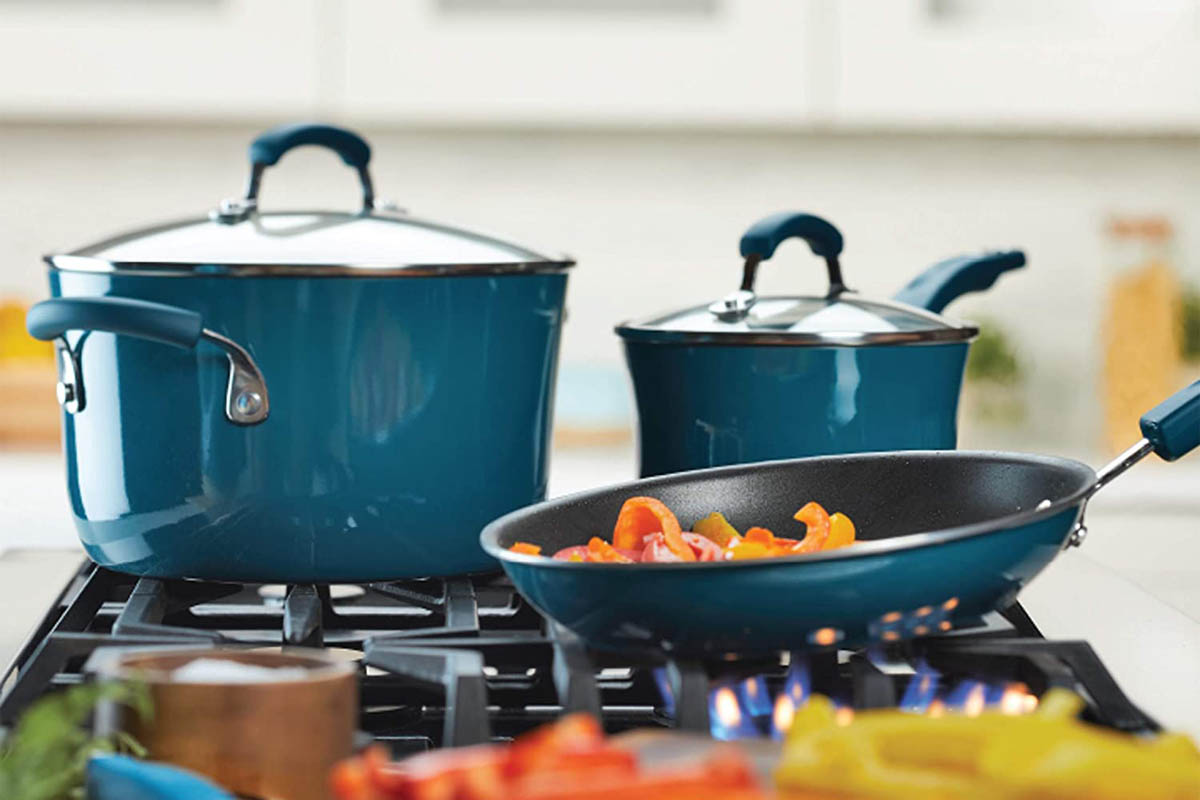
About the Brand: Stylish and colorful, nonstick cookware and bakeware from TV personality Rachael Ray is available at a budget-friendly price.
Price Range: $ to $$$
Rachael Ray is a longtime television personality and cooking show celebrity who doesn’t claim to be a chef. She offers numerous product lines, including kitchen gadgets, dinnerware, pet food, home furnishings, and purses, as well as cookware and bakeware.
The brightly colored nonstick cookware delivers a stylish, upbeat vibe to the kitchen. Easy-grip handles are designed ergonomically, and the materials are durable and easy to care for. Wash Rachael Ray cookware by hand, as the nonstick coating provides easy cleanup for tough messes.
Rachael Ray’s cookware and bakeware are constructed from strong materials such as hard-anodized aluminum, stainless steel, and enamel. The handles on the pots and pans are covered in easy-to-grip silicone for confident handling. The lids are made from heat-resistant glass to offer cooks a clear view of simmering ingredients.
Top Products:
- Rachael Ray Brights Nonstick Cookware Set: The 14-piece set comes in a choice of vibrant colors with comfort-grip silicone handles and double-riveted pot lids. Get the Rachael Ray Brights Nonstick Cookware Set on Amazon for $149.99
- Rachael Ray Create Delicious Stainless Steel Cookware Set: Induction compatible, this 10-piece cookware set is oven safe up to 400 degrees Fahrenheit. Etched measurement marks are included. Get the Rachael Ray Create Delicious Stainless Steel Cookware Set on Amazon for $159.99
- Rachael Ray Create Delicious Hard-Anodized Aluminum Frying Pan: For deep frying, this 12.5-inch pan comes with a lid and silicone handles. Its flared rim makes pouring easier. Get the Rachael Ray Create Delicious Hard-Anodized Aluminum Frying Pan at Walmart for $39.99
Shop for more Rachael Ray cookware at:
9. GreenLife
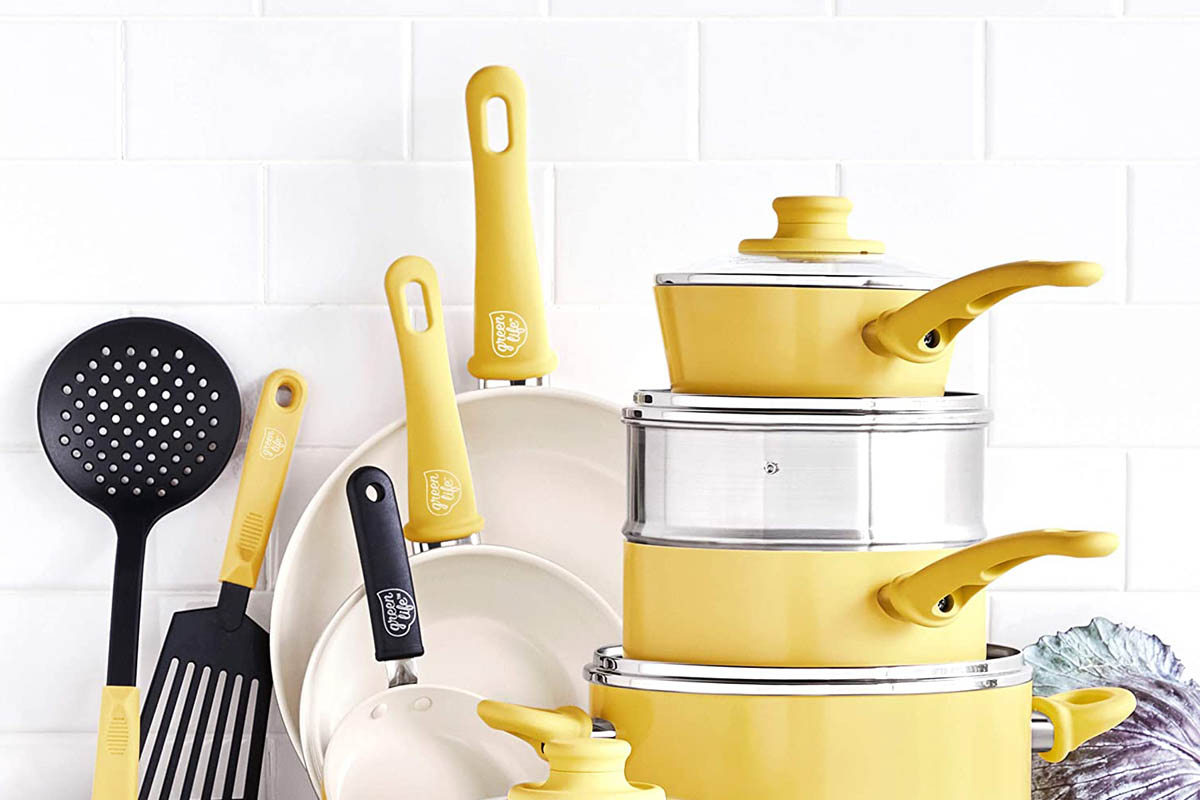
About the Brand: GreenLife’s goal is to make cooking healthier through the use of a nonstick ceramic material that’s non-chemical and nontoxic.
Price Range: $ to $$
GreenLife’s 16-piece set cookware offers a healthy alternative to Teflon for nonstick cooking. Their patented Thermolon ceramic nonstick coating is free from perfluorooctanoic acid (PFOA) and polytetrafluoroethylene (PTFE, known as Teflon). However, Teflon is approved by the FDA for use as a nontoxic coating for cookware and bakeware.
GreenLife is committed to environmentally friendly practices. Their cookware is made from recycled aluminum, and the production of the nonstick ceramic coating creates 60 percent less carbon dioxide emissions than traditional coatings create when curing.
GreenLife cookware helps promote healthy cooking because the nonstick ceramic surface requires only a few drops of oil to facilitate food release. Comfortable cushioned handles provide confident control for cooks. The forged bases of pots and pans prevent wobbling on the stovetop, and glass lids allow users to view the cooking process.
Top Products:
- GreenLife Soft Grip Healthy Ceramic Nonstick Cookware Set: Available in a variety of cheerful colors, this 16-piece set features a ceramic nonstick coating. Get the GreenLife Soft Grip Healthy Ceramic Nonstick Cookware Set on Amazon for $99.99
Shop for more GreenLife cookware at:
10. Circulon
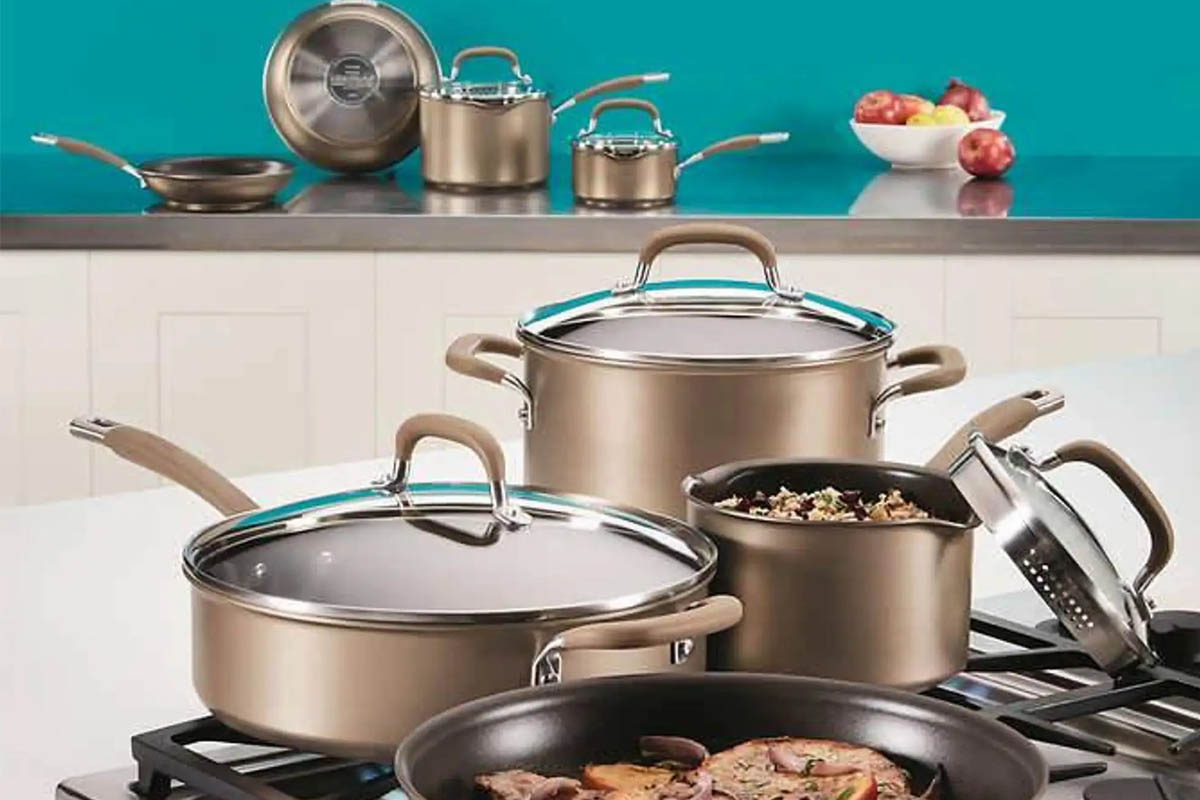
About the Brand: Circulon’s TOTAL Nonstick System utilizes raised circles along with three layers of premium nonstick material to ensure food releases completely from cookware surfaces.
Price Range: $ to $$$
The Circulon TOTAL Nonstick System is available on both interior and exterior cookware surfaces, and the company states that their nonstick surfaces last 10 to 15 times longer than those on competitors’ cookware products. Circulon applies the nonstick system to aluminum hard-anodized aluminum and stainless steel pans, and the nonstick surfaces are reported to resist scratches and wear, even when cooks use metal utensils.
Utilizing heavy-gauge construction processes, Circulon produces cookware that features fast and even heat distribution, eliminating hot spots and promoting satisfactory cooking results. Their product line includes a broad array of cookware and bakeware items along with tea kettles and cooking utensils.
Top Products:
- Circulon Premier Professional 13-Piece Hard-Anodized Cookware Set: The cookware set includes eight nonstick, hard-anodized aluminum pots and pans in various sizes and shapes, along with five shatter-resistant glass lids. Get the Circulon Premier Professional 13-Piece Hard-Anodized Cookware Set on Amazon for $258.99
- Circulon Momentum 11-Piece Stainless Steel Nonstick Cookware Set: Oven safe up to 400 degrees Fahrenheit, this 11-piece stainless steel set has a PFOA-free nonstick system and has shatter-resistant glass lids. Get the Circulon Momentum 11-Piece Stainless Steel Nonstick Cookware Set at The Home Depot for $199.99
Shop for more Circulon cookware at:
11. Farberware
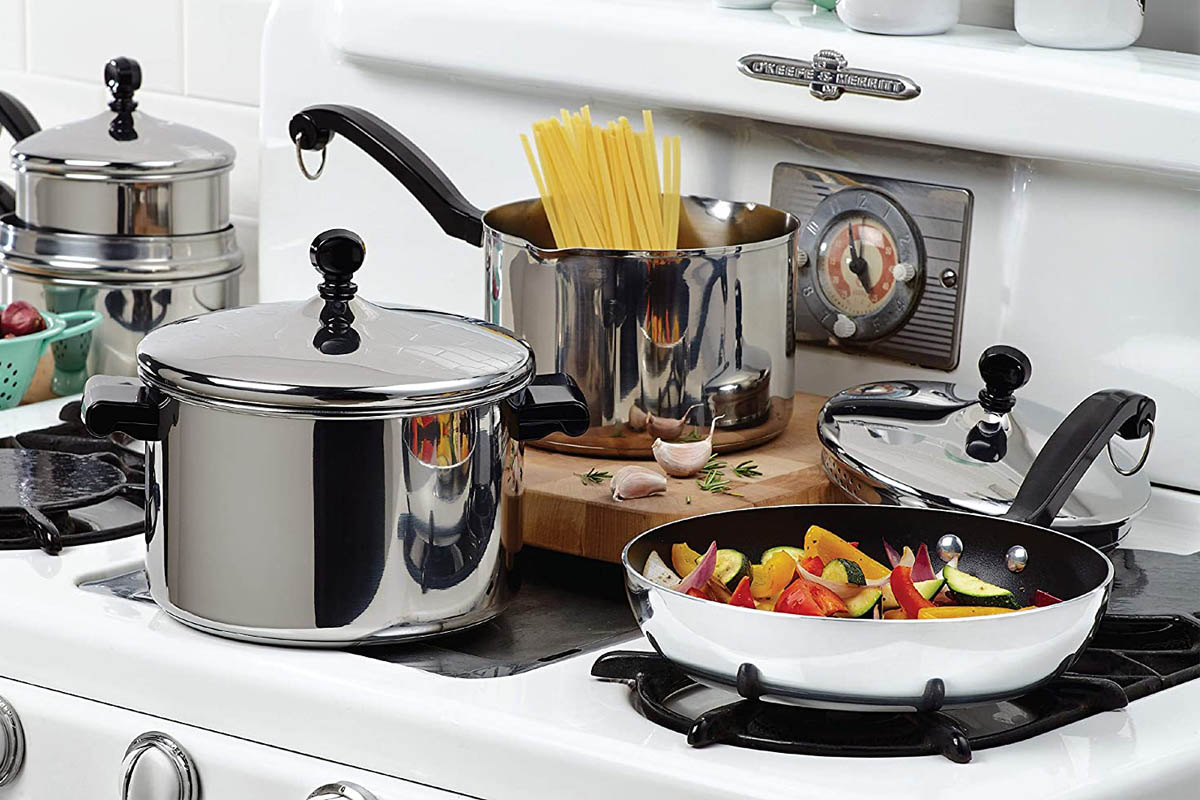
About the Brand: Tracing its roots back more than 120 years, Farberware is a reputable brand that offers reliable quality in aluminum, stainless steel, and ceramic cookware and bakeware.
Price Range: $ to $$
Farberware developed a comprehensive line of cookware and bakeware in aluminum and stainless steel with nonstick and ceramic surface coatings. One of the company’s best-loved products, the stovetop coffee percolator was a fixture in many American kitchens throughout the 20th century.
Today, Farberware cooking vessels feature nonstick coatings on aluminum, hard-anodized aluminum, stainless steel, and ceramic materials. And, yes, they continue to offer their iconic stovetop coffee percolators.
Priced in a budget-friendly range, the cookware is available in sets or individual pieces. Farberware continues to supply home cooks with durable, innovative cooking and baking products, making the company a trusted American brand.
Top Products:
- Farberware Classic Stainless Steel Cookware Set: This set has seven stainless steel pots and pans with nonstick interiors, five stainless steel lids, and three non-metal cooking utensils. Get the Farberware Classic Stainless Steel Cookware Seton Amazon for $149.99
- Farberware Cookstart DiamondMax Nonstick Cookware Set: Made with heavy-duty aluminum, this 15-piece set is oven safe up to 350 degrees Fahrenheit. Get the Farberware Cookstart DiamondMax Nonstick Cookware Set at Kohl’s for $67.49
Shop for more Farberware cookware at:
12. Anolon
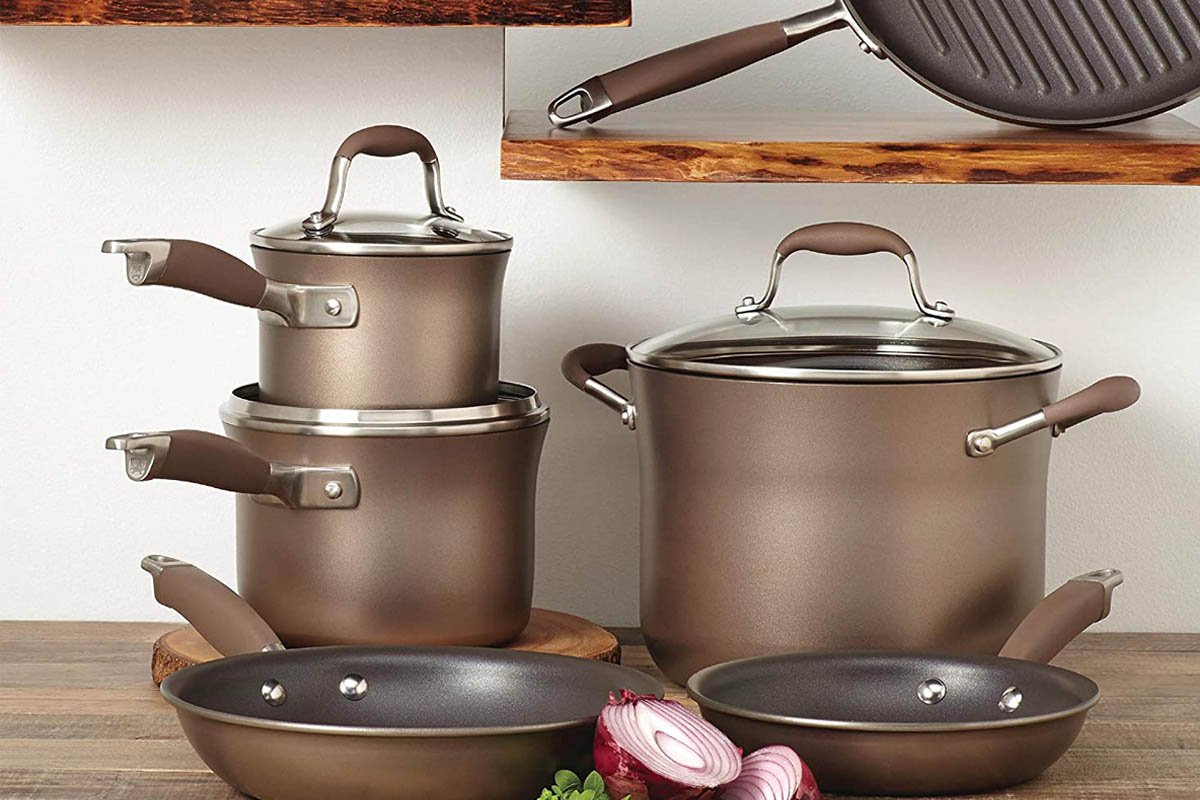
About the Brand: Anolon was the first cookware company to add nonstick coating to hard-anodized aluminum cookware, and their high-quality nonstick technology continues to make the brand a standout in the world of cookware.
Price Range: $ to $$$
Anolon introduced Santoprene, a rubberized material for their SureGrip handles that helps give cooks confidence and control when handling their cooking vessels. Continuing to innovate and improve its products, Anolon offers a nonstick, stainless-steel hybrid material via its AnolonX SearTech system. Stainless steel mesh is inlaid with a high-quality nonstick material to produce exceptionally durable, long-lasting interior and exterior cookware surfaces.
With their large selection of cookware and bakeware items, Anolon offers well-crafted cooking vessels, including Dutch ovens, woks, saucepans, fry pans, steamers, roasting pans, and more. Materials include forged hard-anodized aluminum, stainless steel, stainless steel hybrid inlaid with nonstick material, and stainless steel–clad aluminum.
Top Products:
- Anolon Advanced Nonstick Cookware Set: This 11-piece set is constructed from durable hard-anodized aluminum with a high-quality nonstick coating and SureGrip handles. Get the Anolon Advanced Nonstick Cookware Set on Amazon for $299.99
- Anolon Triply Clad Stainless Steel Stir Fry Wok Pan: With an aluminum core between stainless steel, this stir-fry wok pan is oven safe up to 500 degrees Fahrenheit. Get the Anolon Triply Clad Stainless Steel Stir Fry Wok Pan on Amazon for $49.99
Shop for more Anolon cookware at:
13. Caraway
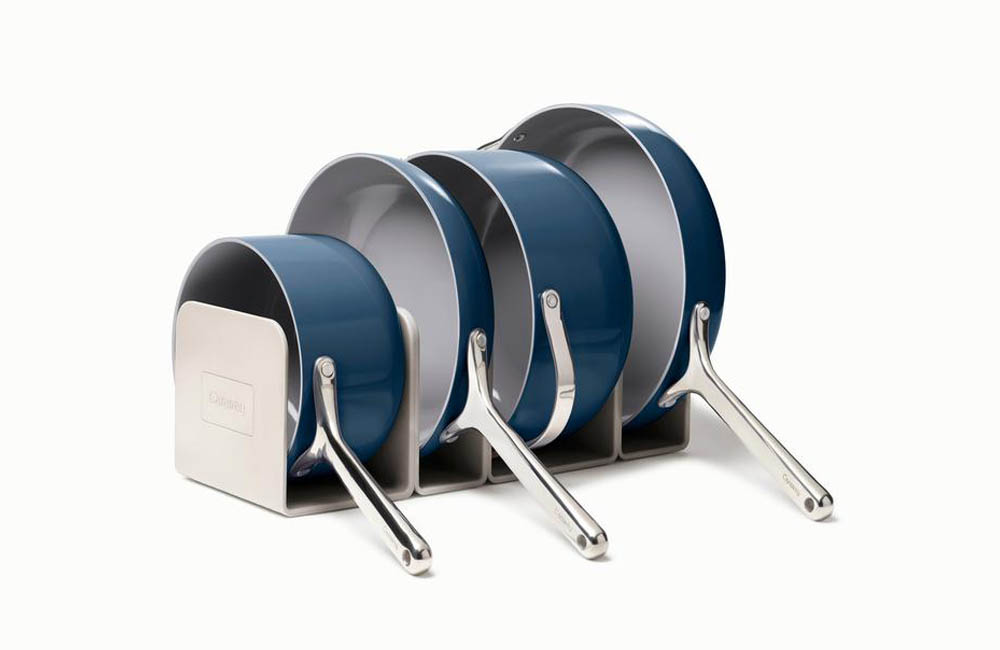
About the Brand: Caraway cookware features elegant and contemporary designs in delicious colors along with a commitment to chemical-free, nontoxic materials and ethical manufacturing practices.
Price Range: $$ to $$$
Founded in 2018 by CEO Jordan Nathan, Caraway cookware is designed in New York City and manufactured in ethically managed factories in China and India.
Caraway is committed to producing chemical-free products using eco-friendly manufacturing processes. Their cookware is made in safe facilities in which workers receive benefits, fair wages, and ethical treatment. Additionally, Caraway utilizes sustainable packaging with zero single-use plastic material.
Caraway cookware is made with no harmful chemicals that could leach into foods. The ceramic-coated aluminum cooking vessels offer slick, nontoxic surfaces to ensure that food releases freely. The product line includes saucepans, sauté pans, fry pans, and Dutch ovens, available in sets or individual pieces.
Top Products:
- Caraway Cookware Set: This set is available in eight colors and includes a fry pan, sauté pan, saucepan, and Dutch oven along with three pot lids. Get the Caraway Cookware Set at Caraway Home for $395
Shop for more Caraway cookware at:
How We Chose the Best Cookware Brands
Choosing cookware brands was based on extensive research into the quality and variety of the products offered from many brands. While not every home cook has the same cooking needs or budget, there are cookware options that can deliver high-quality results at a variety of price points. Even though materials like aluminum and stainless steel tend to be less expensive and have more expected limitations on lifespan and baking temperatures, we included brands and their top products with these materials that offer value and quality at a budget price point. For others who have a more expansive budget, there are top brands on the list that deliver long lifespan and longer durability.
